A sincere attempt is being made with this new series by our website, to now acquaint our readers with the lives of the Orthodox Saints and Martyrs of the original One, Holy, Catholic and Apostolic Church of our Lord, who, like some of the Orthodox Saints of the British Isles, lived and propagated the Faith in the Western territories of the European Continent during the first millennium of Christianity and prior to the Great Schism of 1054 AD.
Saint Rupert (Robert) of Salzburg, Apostle to Bavaria and Austria († 710)
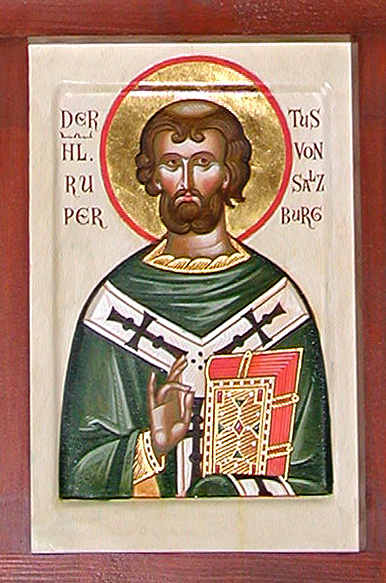
March 27th is the feast of St Rupert, a most holy and blessed man. This feast commemorates the day of his repose, which brings spiritual joy to devout minds and refreshes hearts throughout the entire year. As the Scriptures say, “The righteous shall be in everlasting remembrance.” He who passes into the angels’ joy is made worthy of men’s remembrance: as the Scriptures say, “A wise son is the glory of the father,” and how great is his glory, who redeemed so many barbarian nations through the knowledge of God in Christ Jesus through the Gospel!
When Childebert the king of the Franks was in the second year of his reign, the Bishop of Worms was the Holy Confessor Rupert, who was born into the ranks of the Frankish nobility, but was far more noble in faith and piety. He was gentle and chaste, simple and prudent, devout in praise of God, full of the Holy Spirit. He was also circumspect in his decisions and righteous in his judgment. He possessed great spiritual discernment, and his good deeds formed his flock into true images of Christ, for he inspired them not only with his words, but by the example of his works. He often kept vigil, weakened himself with fasting, and adorned his works with compassion. He gave away his riches that the poor might not go hungry, believing himself to be one who should clothe the naked and help the destitute.
When the great fame of this most venerable man had spread to the ends of the world, powerful men, not only in that region but from other nations, poured in to hear his most holy teaching. Some with many sorrows came to receive consolation through his holy words, and other churchmen came to learn the purity of true Orthodoxy from him. Many were freed from the snares of the ancient enemy by his loving spiritual advice, and were able to set out on the path to salvation. But unbelievers, who were numerous in the vicinity of Worms, not understanding his holiness, exiled him from the city in a most shameful manner. They caused him terrible suffering and beat him with rods. At that time Theodo, the Duke of Bavaria, hearing about the miracles which this most holy man had performed and of his blessedness, desired to meet him. With firm resolve he dispatched his most trusted men to summon him to his court and to enquire of him how long might he consent to visit the regions of Bavaria, and could he instruct him in the way of life-giving faith? The blessed bishop, having received such a sincere and heartfelt request knew that it came from Divine dispensation and thanked the Merciful One, because “those who sat in the darkness and the shadow of death” longed to know the author of life, Jesus Christ.
As a result of this he sent his own priests, as if they were rays of faith, to return with the ambassadors of the Duke, and he himself after a short time undertook the journey to Bavaria. When the Duke heard the news that the blessed one was on his way he was overcome with great joy, and he and a large retinue hastened to meet St Rupert, overtaking the saint in the city of Regensburg. Although exhausted and hungry from his long journey, St Rupert, right away began to reveal to the Duke the mystery of the heavens and instructed him in the Orthodox faith. He convinced the Duke to renounce the worship of idols, and baptized him in the name of the Holy and Indivisible Trinity. The nobles and the simple people were also baptized with the noble duke, praising Jesus Christ the Saviour of the world, who considered them worthy to be called wondrously into His light from their darkness through His confessor, the most blessed Rupert. By his holy words their darkened hearts were enlightened and the souls of the unbaptized thirsted for the fountain of life.
When the saint had revealed Divine Truth by having baptized the Duke and his people, Theodo came to understand the mystery of saving baptism. He begged the holy Rupert to carry the light of Orthodoxy to others and the saint, fulfilling his desire, boarded a ship and sailed down the River Danube. Through the towns, villas, and forts, he declared the gospel of Christ in a great voice. To the ends of Noricum, into the lower parts of Pannonia, he brought the light of the teachings of Christ which illumines all. Having returned by land, he entered Lauriacum (torch on the River Enns), in whose water he baptized many, freeing them from the worship of idols. In the name of Jesus Christ he healed many who had been oppressed by various illnesses and passions. After he left Lauriacum he saw the spiritual darkness of the tribes in that region; he boldly undertook to smash images and to proclaim everywhere the divinity of the Lord Jesus Christ as well as His most holy incarnation. He brought them to believe that He truly is both God and man, truly begotten of the Father before all ages. He taught them that Christ is the Word of God conceived by the Holy Spirit and born of the Virgin Mary for the salvation of mankind.
Having accepted the episcopacy after being entreated to do so by the Duke and his people, he went to the placid waters of Lake Wallersee, where a church had been built in honour of the chief apostle Peter. He moved from there to the Juvavian (Salzach) River, the site of the city of Juvavia, which had been erected in ancient, tumultuous times. At one time it had had great importance among Bavarian cities, but by the time St Rupert arrived it had become overgrown with trees and weeds and only a few people lived among the ruins. The servant of God considered this a suitable place for his episcopal cathedral, because being situated high in the mountains, it was far from the tumult and distractions of crowds. He went before the duke, and spoke to him with great enthusiasm about his plan to build a basilica there in honour of the blessed Peter, Chief of the Apostles. He was granted the vast sums needed to build the splendid church by the generosity of Theodo. When the church was finished he ordained priests, and commanded them to celebrate the daily offices in canonical order. The saint of God then wished to enlarge his holdings in the vicinity of the cathedral, so he petitioned the Duke for yet another donation, and with the funds donated to him he purchased the estate known as Piding for thousands of solidi, a great sum of money at the time. Thus, by the will of God and the bequests of kings, noblemen, and the faithful, the centre of spiritual life for the kingdom began to grow.
Here is an account of a wondrous event in the life of St Rupert. Some very reliable men came to the blessed hierarch and told him of an amazing phenomenon which had taken place when they had gone into an unnamed wilderness area now called Bongotobum (Pongau). Three or four times they had seen heavenly lights shining like bright lamps in the sky and they had also experienced a wonderful fragrance in the same place. The pious bishop sent the priest Domingus to Bongotobum because of the reports which he received concerning these lights. It was his desire that the priest would verify the authenticity of these wonders by erecting in that location a wooden cross which the holy one had made and blessed with his own hands. When Domingus arrived, he at once began the First Hour with the monks who had come with him. They saw a bright heavenly light which descended from the sky and lit up the entire region with the brightness of the sun. Domingus saw this vision on three nights in a row, and experienced the wondrous fragrance as well. He erected the blessed cross in that place, and it was miraculously transported to a spot above the dwelling of St Rupert, confirming the truthfulness of what had been reported to him! St Rupert took word of the miraculous occurrence to Theodo and then he himself went into the wilderness to the very spot, and seeing that it was suitable for habitation, began to cut down aged oaks and brought in building materials that he might build a church with dwellings for a monastic community..
At about the same time, Theodo fell into ill health, and felt the end of his life approaching. He called to his bedside his son Theodobert, appointing him the Duke of Noricum, admonishing him to be obedient to St Rupert and to aid him in his holy work as well as to firmly establish and support the Juvavian church with love, honour, and dignity. He also adjured him to protect and exalt it. When he had instructed his son in all good things and had given him his final testament, he ended his earthly life and fell asleep in the Lord. After the repose of his God-fearing father, Duke Theodobert along with his nobles remained followers of St Rupert because of his great sanctity. Having travelled to see the saint in his far hermitage, the duke honoured him with pious affection and went to pray in the church which the saint had built there. The duke donated three parcels of land in honour of St Maximilian and gave property on all sides of the forest, as well as an estate in the Alps. He gave gifts to support the monastery and the hieromonks whom the most blessed Rupert had ordained for the Service of God.
When this had been accomplished, the man of God saw that the most noble man of Bavaria had submitted himself to the yoke of Christ and had left worldly concerns to the lesser men of his kingdom. St Rupert then accompanied the duke back to his homeland and then returned with twelve of his closest spiritual children (among whom were Kuniald and St Gisilarius, both priests and both holy men). His niece, St Ermentrude, a virgin dedicated to Christ also accompanied them to the city of Juvavia. There in the main fortress of the city he built a monastery in honour of Our Lord Jesus Christ the Saviour and His Most Pure Mother, the Ever-Virgin Mary. He placed as abbess in that monastery St Ermentrude, that she might serve the King of Heaven. With the generous support of Duke Theodobert, who gave many gifts to the nuns, he established a monastery which had all its spiritual and physical needs well taken care of.
When all this had been accomplished, the blessed man became eager to complete the missionary efforts he had begun with the help of Christ. Accompanied by clergy and monastics, he resolved to visit his followers in the Norican kingdom. Having left the city of Juvavia he visited people on whom the light of faith had not yet shown, and he sowed the wheat of faith amid tares. The deception of the devil fled from the hearts of these barbarian tribes, and Rupert sowed in its place faith, love, mercy, and humility, for through these Christ, the giver and source of all good, is able to take up residence in the human heart. He travelled to all the ends of Bavaria, and converted the people to faith in Christ, and strengthened those who had remained steadily faithful. Having sent out several priests and men of God who brought the Divine Mysteries to the people, he became anxious to return to Juvavia. Because he had the gift from God of knowing the future, he knew that the day of his repose was at hand. He revealed this to his disciples, who were filled with sorrow and anguish. Because of this, there was much weeping and great mourning when he took leave of his newly enlightened Christian flock.
Filled with certainty and faith in Christ, St Rupert commended the city, the Norican people, and all who had been received into holy Orthodoxy to the Most High and All-Knowing God. He chose Vitale, a holy man whom the people themselves had accepted, as his successor. When the forty days of Great Lent had passed, Bishop Rupert became very ill and was exhausted by a high fever. When the most holy day of the Resurrection of Our Saviour Jesus dawned, he celebrated the solemn Liturgy, and was fortified for his final journey with the precious Body and Blood of Christ. He comforted his priests, monastics and flock with a beautiful sermon filled with much love. Then, surrounded by his weeping spiritual children he breathed his last and returned his most pure soul to God. A host of angels were sent by Christ and the saints in the heavens who bore his holy soul with melodious voices to eternal happiness. Thus the faithful servant of God rested in peace. He whose life was praiseworthy and blameless was in death equally blessed. Thus it is written: “Precious in the sight of the Lord is the death of His saints.” Shortly after his repose many miracles were attributed to him, for God was gracious through the relics of His saint and manifested His tender mercy. By the prayers of the friend of God, St Rupert, the faithful were comforted and the Church adorned through innumerable miracles. Indeed the Blessed God, One in three Persons, lives and reigns; to Him be all praise and glory unto the ages of ages. Amen.
Saint Wolfgang, Bishop of Ratisbon, Bavaria(† 994)
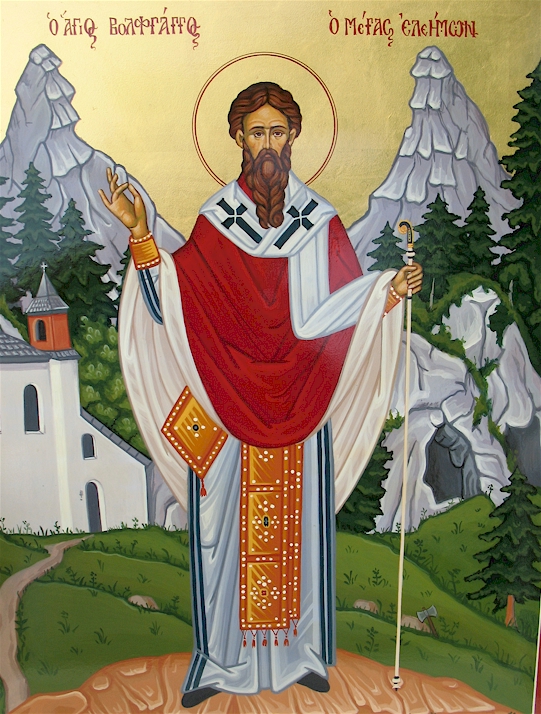
Our father among the Saints Wolfgang, Bishop of Ratisbon, the glorious light of Bavaria, was born of illustrious parents about the year 934.
After studying at Reichenau and Würzburg, he led the cathedral school at Trier, and undertook to reform the churches of the area, for which he met with hostility.
He began to live an ascetic life and after some years became a monk at Einsiedeln, then was ordained priest by St. Ulric of Augsburg. Together with St. Ulric and St. Conrad, St. Wolfgang was one of the three Stars in the firmament of the Orthodox Church in pre-Schism Germany.
Wolfgang was sent as a missionary to the pagan Magyars, and later, in 972, was made Bishop of Ratisbon.
He became the tutor to Emperor St. Henry II, was spiritual father and mentor to several of the early 11th c. German bishops, and restored genuine monastic life in the region.
He was a zealous preacher, and his liberality to the poor earned him the title of “Elemosynarius Maior,” that is, “The Great Almsgiver.”
Once, in the midst of a political controversy, St. Wolfgang disappeared. A hunter found him living as a hermit near a lake now called Lake St. Wolfgang, and he returned to his see.
Then, while visiting Pöchlarn in Lower Austria, upon the Danube, the Saint took ill and reposed soon after. His sacred relics were transported up the Danube to Ratisbon and there enshrined.
His holy life was written in 1050.
Saint Wigbert, Abbot of Fritzlar, Germany(† 797)
St. Wigbert was a priest and companion of St. Boniface (Winfred), apostle to Germany.
He became abbot at Fritzlar (Tritzlar) in Germany.
St. Wigbert was born in England about 675. He was known for the purity of his morals, his zeal for the salvation of souls, his boundless love, his penetrating knowledge and familiarity with the Scriptures.
He had great skill in teaching, struggled excellently in monastic podvig, and was faithful in all matters. St. Boniface summoned him from England to Germany, so in about the year 734 St. Wigbert went to Germany, and there he was made abbot of the monastery of Hersfeld in Hesse. Among his pupils was St. Sturmi, first abbot of Fulda.
About 737 Boniface transferred him to Thuringia as abbot of Ohrdruf, where he worked with the same success as in Hersfeld. Later, Wigbert obtained Boniface’s permission to return to Hersfeld to spend his remaining days in stillness and to prepare for the hour of death.
Even in old age and in illness he continued his austere mode of life, until the very end. The Saint reposed at Hersfeld in about 746.He was first buried at Fritzlar in an inconspicuous grave, but during an incursion of Saxons (774) his remains were taken for safety to Buraburg, and from there, in 780, his sacred relics were transferred by Abp. St. Lullus to Hersfeld.
In the year 850 a beautiful church was built to him, but it burned down in 1037. A new church was built and dedicated in 1144 but it burned in 1761 in a great fire, after which his sacred relics were never found again by men.
Holy Venerable Father Wigbert, pray to God for us!
Feast: Aug. 13
Saint Severinus, Apostle of Austria(† 482)
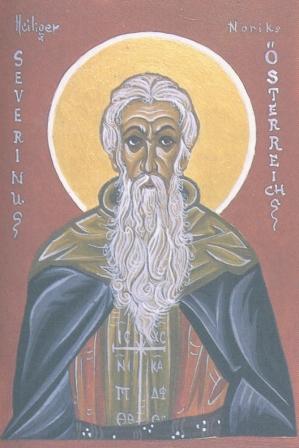
St. Severinus came to the borderland of present-day Germany and Austria from the east — possibly the Egyptian desert — to care for the Roman Christians who were endangered by invading barbarians during the collapse of the Roman Empire.
He remained there until the end of his life. While he was there he advised both common people and kings to put eternal life first, and taught them to be generous to one another and to lead a true Christian life.
He built a monastery and protected from harm those who gathered around him. As he foretold, the monks and other Christians who had followed him escaped to saftety in Italy, taking St. Severinus’ incorrupt relics with them.
His relics are still honored in Frattamaggiore, Italy (near Naples).
—from the 2006 Saint Herman Calendar
Saint Ansgar (Anskar, Anschar, Anscharius, Scharies) of Germany and Evangelist of Scandinavian lands († 865)
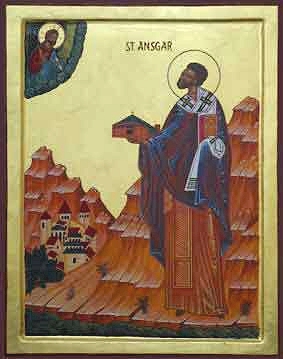
Born near Amiens, Picardy, France in 801, died in Bremen, Germany on February 3, 865.
With the coming of the barbarians after the death of Charlemagne, darkness fell upon Europe. From the forests and the fjords of the north, defying storm and danger, came a horde of pirate invaders, prowling round the undefended coasts, sweeping up the broad estuaries, and spreading havoc and fear. No town, however fair, no church, however sacred, and no community, however strong, was immune from their fury. Like a river of death the Vikings poured across Europe.
It’s hard to believe that there would be an outbreak of missionary activity at such a time, but in Europe’s darkest hour there were those who never faltered, and who set out to convert the pagan invader. St.Ansgar was such a man. As a young boy of a noble family he was received at Corbie monastery in Picardy and educated under Saint Abelard and Paschasius Radbert. Once professed, he was transferred to New Corbie at Westphalia. He once said to a friend, ” One miracle I would, if worthy, ask the Lord to grant me, and that is, that by his grace, he would make me a good man.”
In France a call was made for a priest to go as a missionary to the Danes, and Ansgar, a young monk, volunteered. His friends tried to dissuade him, so dangerous was the mission. Nevertheless, when King Harold, who had become a Christian during his exile, returned to Denmark, Ansgar and another monk accompanied him. Equipped with tents and books, these two monks set out in 826 and founded a school in Denmark. Here Ansgar’s companion died, and Ansgar was obliged to move on to Sweden alone when his success in missionary work led King Bjørn to invite him to Sweden.
On the way his boat was attacked by pirates and he lost all his possessions, arriving destitute at a small Swedish village. After this unpromising start, he succeeded forming the nucleus of a church — the first Christian church in Sweden — and penetrated inland, confronting the heathen in their strongholds and converting the pagan chiefs.
Ansgar became the first archbishop of Hamburg, Germany and abbot of New Corbie in Westphalia c. 831. The Pope Gregory IV appointed him legate to the Scandinavian countries and confides the Scandinavian souls to his care. He evangelized there for the next 14 years, building churches in Norway, Denmark and northern Germany.
He saw his accomplishments obliterated when pagan Vikings invaded in 845, overran Scandinavia, and destroyed Hamburg. Thereafter the natives reverted to paganism. Ansgar was then appointed archbishop of Bremen around 848, but he was unable to establish himself there for a time and Pope Nicholas 1 united that See with Hamburg. Nicholas also gave him jurisdiction over Denmark, Norway, and Sweden.
Ansgar returned to Denmark and Sweden in 854 to resume spreading the Gospel. When he returned to Denmark he saw the church and school he had built there, destroyed before his eyes by an invading army.
His heart almost broke as he saw his work reduced to ashes” The Lord gave,” he said, “and the Lord have taken away. Blessed be the name of the Lord.” With a handful of followers he wandered through his ruined diocese, but it was a grim and weary time. “Be assured my dear brother, ” said the primate of France, who had commissioned him to this task, “that what we have striven to accomplish for the glory of Christ will yet, by God’s help, bring forth fruit.”
Heartened by these words, and with unfailing courage, Ansgar pursued his Swedish mission. Though he had but four churches left and could find no one willing to go in his place, he established new outposts and consolidated his work.
King Olaf had cast a die to decide whether to allow entrance of Christians, an action that Ansgar mourned as callous and unbefitting. He was encouraged, however, by a council of chiefs at which an aged man spoke in his defense. “Those who bring to us this new faith,” he said” by their voyage here have been exposed to many dangers. We see our own deities failing us. Why reject a religion thus brought to our very doors? Why not permit the servants of God to remain among us? Listen to my council and reject not what is plainly for our advantage.”
As a result, Ansgar was free to preach the Christian faith, and though he met with many setbacks, he continued his work until he died at the age of 64 and was buried at Bremen. He was a great missionary, an indefatigable, outstanding preacher, renowned for his austerity, holiness of life, and charity to the poor. He built schools and was a great liberator of slaves captured by the Vikings. He converted King Erik of Jutland and was called the “Apostle of the North”, yet Sweden reverted completely to paganism shortly after Ansgar’s death.
Ansgar often wore a hair shirt, lived on bread and water when his health permitted it, and added short personal prayers to each Psalm in his Psalter, thus contributing to a form of devotion that soon became widespread.
Miracles were said to have been worked by him. After Ansgar’s death, the work he had begun came to a stop and the area reverted to paganism. Christianity did not begin to make headway in Scandinavia until two centuries later with the work of Saint Sigfried and others. A life story was written about Ansgar by his fellow missionary in Scandinavia, Saint Rembert (Attwater, Attwater2, Benedictines, Bentley, Coulson, Delaney, Encyclopedia, Fanner, Gill, Robinson, White)
In art Ansgar is shown with converted Danes with him (White), wearing a fur pelisse (Roeder). He may sometimes be shown otherwise in a boat with King Harold and companions or in a cape and miter Hamburg Cathedral (Roeder).
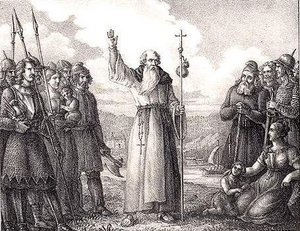
Saint Ansgar is the patron of Denmark, Germany and Iceland (White). He is venerated in Old Corbie (Picardy) and New Corbie (Saxony) as well as in Scandinavia (Roeder).
Sourse ‘Orthodox Outlet for Dogmatic Enquiries’


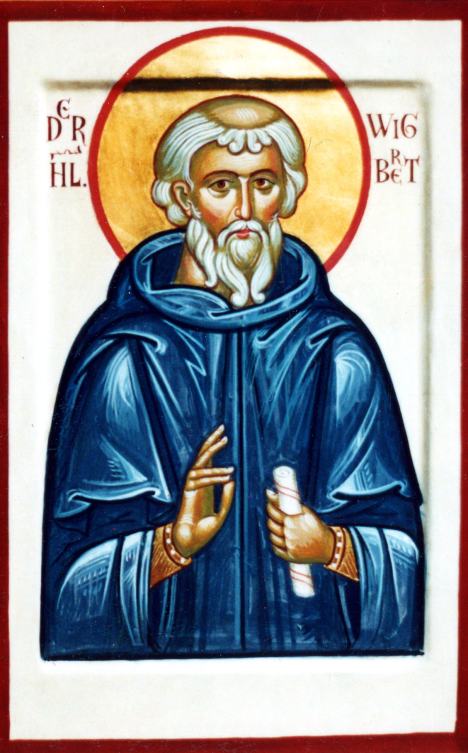
Δεν υπάρχουν σχόλια:
Δημοσίευση σχολίου